
* The Tu-16 proved a very capable platform, not only being used as a bomber and missile carrier, but also in reconnaissance, electronic warfare, and special-mission roles. It was exported to a number of users, with the Chinese manufacturing their own copies as the "H-6", which is still in production.
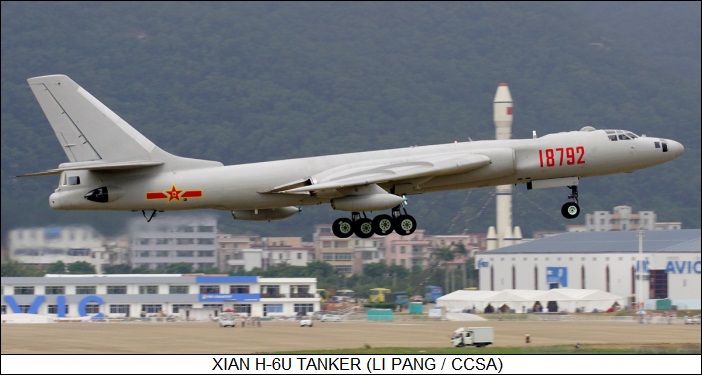
* The capability of the Tu-16 made it an attractive reconnaissance platform from the outset, and the initial reconnaissance variant, the "Tu-16R", began production in 1957. The Tu-16R was given the NATO reporting name of "Badger-E". The equipment fit tended to vary over time, but generally included a number of film cameras, plus electronic intelligence (ELINT) gear to detect and characterize radars or other radio "emitters", and an RPB-4/RPB-6 radar. The Tu-16R also carried countermeasures gear, including an SPS-1 jammer and chaff-flare dispensers. All armament was retained. 75 Tu-16Rs were built in all.
A seventh crewman, an ELINT operator, rode in a compartment in the weapons bay, which also carried chaff-flare dispensers. The crewman operated the SRS-1 manual ELINT system, which featured twin small radomes under the fuselage. The SRS-3 automatic ELINT system, which recorded ELINT data on film strips, was later added, identifiable by a small pod under each wing; NATO, which could only really classify most Soviet aircraft by their superficial appearance, gave this configuration a new reporting name of "Badger-F", though it was still just a Tu-16R. The SRS-1 system was later upgraded to the SRS-4 ELINT system, which featured larger radomes under the fuselage.
In the late 1970s, a number of Tu-16Rs were upgraded through the installation of improved film cameras, a Rubin-1K radar, and the SRS-4 ELINT system, which replaced the SRS-1 and SRS-3 ELINT systems. These machines were redesignated "Tu-16RM"; as far as NATO was concerned, they were just Badger-Es.
In 1967, a Tu-16R was converted into a "radiological reconnaissance" variant, carrying radiation dosimeters and underwing air filter pods to trap traces of fallout. This variant was designated "Tu-16RR"; it seems that it proved satisfactory, since eight more Tu-16Rs were converted to the same spec in 1970.
* In the mid-1960s, a dozen Tu-16Rs were modified to act as oceanic "hunters" to find targets for Badger missile-carrying "killers", the hunters using ELINT systems to locate adversary naval assets, and the crew then passing the target data back to the killers. The hunter aircraft, which were designated "Tu-16RM-2", featured a fuel tank in the weapons bay to extend range -- the ELINT systems operator position in the weapons bay was deleted, as was the nose cannon -- and were fitted with Rubin-1K radar, the SRS-4 ELINT system and two film cameras. The navigator-bombardier handled the ELINT system.
However, as the range of the missiles increased, the reach of the Rubin-1k radar increasingly fell short. That meant fitting the long-range YeN radar, which in turn meant that the hunters would then have to be rebuilt from the Tu-16K-10-series K-10S missile carriers. Aircraft were modified by:
The modified aircraft were designated "Tu-16RM-1", a total of 24 conversions being performed. NATO assigned the variant the reporting name of "Badger-D".
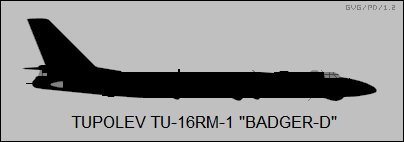
Sources also mention a "Tu-16RC" variant, which was fitted with the MRSC-1 Uspekh system that allowed the aircraft to direct missiles launched from ships or submarines. It is unclear if it was an upgrade of the Tu-16RM-1 or the older Tu-16R reconnaissance variants -- but given that the Uspekh was fielded in the late 1960s, when long-range missiles were in service, it seems likely to have been a Tu-16RM-1 upgrade.
* Western naval forces became very familiar with reconnaissance Badgers. Carrier groups would dispatch fighters to escort intruding Tu-16s, so the Badger pilots learned to stay low, occasionally rising to get a target fix, then dropping down low again and changing course. The goal of the game was to fly right over the carrier group and get some pictures. In one well-known incident captured partly on film, a Badger attempting to evade a British fighter dropped a wingtip into the sea and cartwheeled to its destruction.
In 1968, the USSR signed an agreement with Egypt to base six AVMF Tu-16Rs in that country. These aircraft were flown by Soviet crews but featured Egyptian markings; they were eventually joined by a contingent of electronic warfare Badgers, described below. Egypt was apparently a very pleasant duty station, with the crews enjoying accommodations and luxuries well above anything they could have had back home. The US Sixth Fleet in the Mediterranean found the "Egyptian" Badgers a common sight up until the mid-1970s, when the Egyptians decided that the prosperous US was a more desireable patron than the threadbare USSR.
Tu-16Rs also performed reconnaissance missions during the Afghan War, identifying targets for Badger bombers and other strike aircraft.
BACK_TO_TOP* Badgers were also used in the electronics countermeasures / electronic warfare (ECM/EW) role from early on. In 1955:1957, 42 Tu-16s were built with the SPS-1 jammer system, with 102 built with the more powerful SPS-2 jammer system. Both of these variants were designated "Tu-16SPS"; they featured the SRS-1 ELINT system to spot emitters, with a seventh systems operator in the weapons bay then tuning the jammer systems to deal with them. The SRS-1 jammer system used a set of whip antennas, while the SRS-2 jammer system used twin antenna domes under the forward fuselage. NATO assigned the variant the reporting name of "Badger-K", though the EW Tu-16s would prove confusing: Western observers wondered with some good reason if any two of them were completely alike.
The Tu-16SPS machines were later updated with three ASO-16 chaff dispensers in the weapons bay, their presence revealed by dispenser ports in the bay doors. Beginning in 1962, over 90 Tu-16SPS machines were fitted with the much improved "Buket" countermeasures system, which featured four jamming transmitters that covered a wide band and featured automatic operation. These aircraft were designated "Tu-16P Buket" and were distinguished by a long canoe fairing on the belly; they were labeled "Badger-J" by NATO. A few were later fitted with the Fikus directional jammer system, to be given the reporting name of "Badger-L"; and one was evaluated for carriage of chaff-laying rockets, though that scheme was not fielded.
Another EW variant of the Badger, oriented towards chaff-laying, was developed in parallel with the Tu-16SPS. The "Tu-16 Yolka (Fir Tree)" featured a weapons bay crammed full of seven ASO-16 chaff dispensers, and was also fitted with the SPS-4 jammer system. The AVMF obtained at least 71 Tu-16 Yolkas in the late 1950s, some of them being new-built aircraft, others upgrades from Tu-16T torpedo bombers. NATO assigned the type the reporting name of "Badger-H".
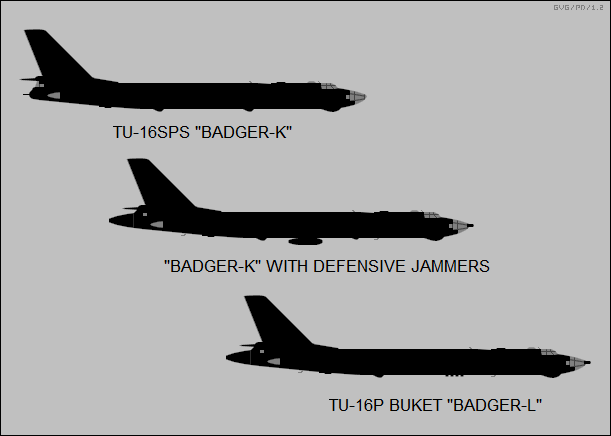
The EW Badgers were fitted with improved jammer systems through the course of their operational lives, and were eventually fitted with flare dispensers in the main landing gear pods to distract heat-seeking missiles. Two Tu-16SPS-type machines were fitted with additional gear for photographic, chemical, and radiological observations, to be designated "Tu-16E".
Badger jammers also served in Afghanistan, blinding Pakistani radars. Since the Pakistanis did not take action against Soviet aircraft unless they strayed into Pakistani airspace, the jamming was likely just to prevent the Pakistanis from tipping off Mujahedin guerrillas to warn them of airstrikes.
BACK_TO_TOP* In the early 1960s, 14 Badgers were converted into a "search and rescue" configuration, carrying a large rescue boat that could be paradropped to survivors of maritime disasters, and redesignated "Tu-16S". They were never actually used in this role, not seeming all that well suited to it in the first place, and were finally scrapped in the early 1980s. Some demilitarized Tu-16s were used by Aeroflot for a time as fast mail carriers prior to the introduction of the Tu-104 airliner. These Tu-16s were designated "Tu-16G" or sometimes "Tu-104G".
There were a number of special modifications for survey photography and aerial filming, as well as weather research and alteration. Tu-16s fitted for cloud-seeding were used following the 1986 Chornobyl nuclear disaster to try to break up radioactive clouds. Many retired Tu-16s ended up as radio-controlled targets ("mishen"). The first such drone conversions were in 1965, with the targets designated "Tu-16M".
The Tu-16 proved very useful as a trials aircraft, particularly for engine tests, with engines often placed on a pylon in the weapons bay that was extended once the aircraft was in flight. A similar carriage arrangement was used with the entire fuselage of a Yak-38 VTOL fighter to test its propulsion system. One Badger was fitted with the nose of a Myashishchev M-17 "Mystic" survey aircraft. These trials Badgers were sometimes designated "Tu-16LL", where "LL" meant "letuschaya laboratoriya (flying laboratory)", a general Soviet suffix designating a test aircraft.
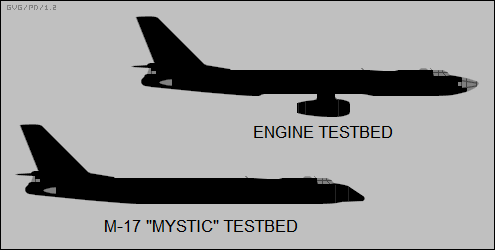
* The Tu-16 began to be retired from Soviet service from the late 1970s with the introduction of the Tupolev Tu-22M "Backfire", but it took a long time to build up Tu-22M stock to useful levels. When the Tu-22M was grounded for a time in 1991, the Badger actually saw a short-lived resurgence, but once the Tu-22M returned to flight, the Tu-16 rapidly declined in numbers. The Tu-16's operational service did not include a great deal of combat action, but the type did in the end prove to be a very capable, flexible, reliable, and safe aircraft.
BACK_TO_TOP* The Tu-16 was flown by a number of export users. The most significant was Red China, which signed a license production agreement with the USSR in 1957 to build the type. The first Chinese Tu-16, or "Hong 6 (H-6)" as it was designated in Chinese service, flew in September 1959, this machine being one of two built at the Harbin aircraft plant from Soviet-supplied knockdown kits.
Due to rising tensions with the USSR, with the result that the two prototypes had to be reverse-engineered to come up with specs, production of the indigenous "H-6A" at the Xian plant did not begin until 1968. Building them was troublesome at the outset because of the massive dislocations of Chairman Mao Zedong's Cultural Revolution, but at least 150 were built into the 1990s, serving with the Chinese People's Liberation Army Air Force (PLAAF).
The H-6A was capable of both conventional and nuclear bombing, doing the honors for nuclear drop tests from the mid-1960s. The H-6A normally flew in spiffy overall white colors. An "H-6A-II" was introduced in the mid-1970s that featured general systems updates as well as curved, low-drag wingtips -- followed by an "H-6C" at the end of that decade that featured improved defensive countermeasures systems. They were followed in turn in the 1980s by the very similar "H-6E" nuclear bombing and "H-6F" conventional bombing variants, with further improved systems.
An "H-6B" strategic reconnaissance variant was built in parallel with the H-6A, presumably with improvements added in parallel to those given the bomber series. Some of the first-generation H-6 machines were configured to carry target drones, one under each wing; it is unclear if these aircraft had any special designation. There are tales of EW and other special-mission variants of first-generation H-6 aircraft -- but though that sounds plausible, details are lacking. It appears the first-generation H-6 variants are now generally out of service.
* The second generation of H-6s was introduced in the mid-1980s, beginning with the "H-6D", an anti-ship missile carrier for the PLA Navy Air Force (PLANAF). It carried a YJ-6 / C-601 anti-shipping missile (NATO "Silkworm", an air-launched derivative of the Soviet P-500 Permit / NATO "Styx") under each wing. The H-6D featured various modernized systems and sported an enlarged flat-bottomed nose radome, as well as enlarged engine intakes. From the early 1990s some H-6Ds were kitted up as tankers, with a hose-drogue pod under each wing, these machines being designated "H-6U". They were followed late in the decade by new-build "HU-6" tankers, of similar configuration but with a solid nose and no undernose radome.
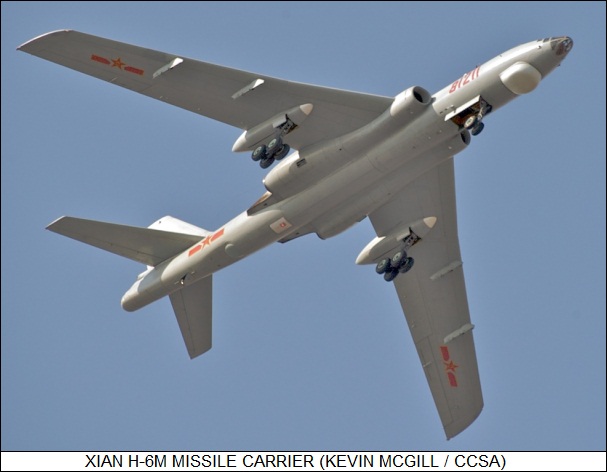
From 2005, the H-6D was replaced in PLANAF service by an improved missile carrier, the "H-6G", which could carry four YJ-83 / C-802 anti-ship missiles -- a turbojet-powered weapon in the class of the French Exocet anti-ship missile -- on underwing pylons. The H-6G had enhanced avionics, most notably a comprehensive countermeasures suite. It could also carry large jammer pods on underwing pylons.
In the meantime, the PLAAF acquired H-6 missile carriers as well, beginning with the "H-6H", carrying twin KD-63 land attack cruise missiles (LACM), the KD-63 being a turbojet-powered weapon apparently derived from the Silkworm. The H-6H was introduced in 2002; it featured a distinctive teardrop radome behind the bomb bay.
The H-6H was followed after the turn of the century by the "H-6M", with pylons for four YJ-81 anti-ship missiles or KD-88 LACMs -- the two being similar weapons in class with the French Exocet anti-ship missile. These variants had no internal bomb capability. They were apparently all rebuilds from H-6E/F machines.
A heavily modernized variant, the "H-6K", performed its first flight in 2007, this machine featuring:
The H-6M was apparently introduced as a stopgap until the more modern H-6K was put into full service. A further modernized "H-6N" became known in 2019 -- distinguished by an aerial-refueling probe in the nose, and modified bomb bay doors to allow it to carry larger external stores.
There have also been electronic-warfare modifications of the H-6 littered with antennas and radomes, designated "HD-6", though little is known of them. At least one H-6A was modified as the "H-6LV" -- the "LV" meaning "launch vehicle" -- for trials of an air-dropped satellite launcher, the "ShenLong (Divine Dragon)", but the ShenLong has not been put into service. It's not even clear it got out of mockup stage.
The persistence of the Tu-16 in production as the H-6 is a tribute to the utility of an old design, though it must be said that the Chinese have stayed with the Tu-16 design from lack of anything better. Still, the H-6 can do the job, and with modern stand-off weapons remains an effective weapons system. Chinese H-6s have been exported to a number of nations as the "B-6", as detailed below. It is believed the Chinese are working on a next-generation bomber, the "H-20", to be introduced sometime during the 2020s. No facts are available, but hints suggest the Chinese are interested in a "stealthy" flying wing along the lines of the US B-2 stealth bomber.
BACK_TO_TOP* Egypt was a long-time user of the Tu-16, receiving a handful of Tu-16KS missile launchers in the spring of 1967, just in time for the Israelis to blast them into scrap on the ground during the six-day June war in that year. The Egyptians were undeterred by this setback and rebuilt their Badger fleet, obtaining hand-me-down Soviet Tu-16Ts (presumably to be used as free-fall bombers), Tu-16KSR-2-11 missile launchers, and Tu-16R reconnaissance machines.
The Egyptians did much better with the Tu-16 in the October 1973 war, suffering no losses of their Badger fleet by basing the machines in the rear, and launching 25 missiles at Israeli targets, claiming five hits on radar sites and other ground targets. When Egypt switched sides to the US after that conflict, spares and some complete B-6 aircraft were obtained from Red China. Egyptian Badgers saw more combat during a four-day border clash with Libya in 1977. Egyptian Tu-16s also participated in combat exercises with US forces. By the early 1990s, the fleet was being scaled back, and the last Egyptian Badgers were retired in 2000.
* Indonesia obtained 25 Tu-16KS machines in 1961, but spares supplies dried up following a break in relations with the USSR in 1965, and the aircraft were soon grounded.
Iraq obtained eight Tu-16s just prior to the June 1967 war, but they saw no action; six Tu-16KSR-2-11 missile carriers obtained after the conflict. The Badger saw combat against the Kurds in 1974 and saw a fair amount of combat in the Iran-Iraq War of the 1980s, even performing bombing raids on Tehran. The Iraqis obtained four B-6Ds with C-601 missiles during the conflict. The career of the Badger in Iraqi service came to an abrupt end in the 1991 Gulf War, being bombed out of existence by Coalition strike aircraft. Any that survived fell into disrepair.
BACK_TO_TOP* The Soviet Union produced a total of 1,509 Tu-16s. 650 were built at the Kazan plant from 1953 into 1959, with 150 more built for Naval Aviation from 1961 into 1963. The Kuibyshev plant built 543 Tu-16s, while the Voronezh plant built 166 up to 1957. The following list gives a variant summary:
* The Tu-16 bomber can be regarded as the Soviet counterpart to the US Boeing B-47 Stratojet, with the two aircraft being similar in size and capability. It is arguable that the Badger is as elegant as the B-47, but then again the B-47 was an unusually sleek aircraft, and the Tu-16 has a certain clean, businesslike, and distinctly Soviet appearance of its own. However, in terms of flexibility and length of service, the Badger wins the contest hands down: it's still being flown, decades after the last B-47 was retired from service.
The flexibility and length of service of the Tu-16 makes it a bit troublesome to document, and Soviet aircraft are difficult subjects anyway. Older books available in the West on the subject before the fall of the USSR are vague, confused, and confusing. However, even with the much more accurate materials available now, it's still tough sledding, and I'm fairly sure some corrections will have to be made down the road.
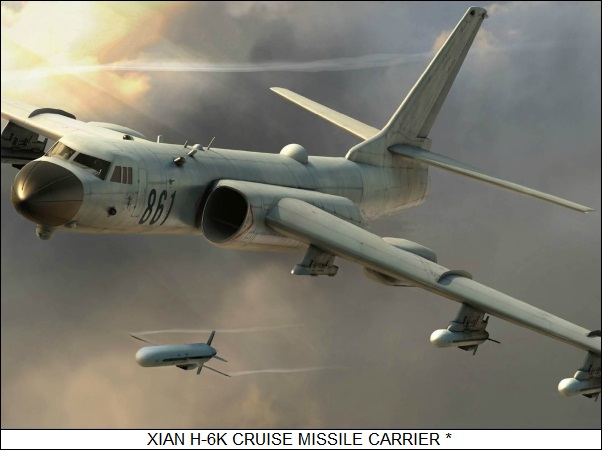
* Sources include:
* Revision history:
v1.0.0 / 01 may 06 v1.0.1 / 01 aug 06 / Typo corrections. v1.0.2 / 01 aug 08 / Review & polish. v2.0.0 / 01 jan 09 / Cut sections on Tu-104 & T-124 jetliners. v2.0.1 / 01 dec 10 / Review & polish. v3.0.0 / 01 nov 12 / H-6 enhancements, went to two chapters. v3.0.1 / 01 oct 14 / Review & polish. v3.0.2 / 01 sep 16 / Review & polish. v3.0.3 / 01 aug 18 / Review & polish. v3.0.4 / 01 jun 20 / Review & polish. v3.0.5 / 01 apr 22 / Review & polish. v3.0.6 / 01 mar 24 / Review & polish.BACK_TO_TOP
